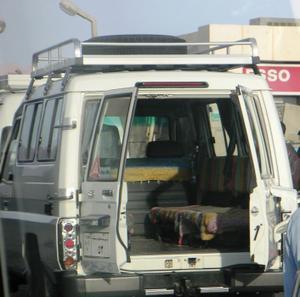Advertisement
Published: January 29th 2006

 4WD
4WD
... let\'s go!After spending whole Sunday in Ras Mohamed, this breathtaking spot with its nutrient rich waters which attract hundreds of thousands of living species to its immensely diverse coral reef, I decided to see the desert as well.
The Sinai Peninsula (in Arabic, Shibh Jazirat Sina شبه جزيرة سيناء) is a triangle-shaped peninsula of about 60,000 square kilometers, lying between the Mediterranean Sea (to the north) and Red Sea (to the south). In Arabic, Sinai is written as sena'.
Because Sinai looks like as the surface of the moon one theory says that the name Sinai derived from the lunar deity Sin. Early inhabitants, worshipping the Trinity: Sin (Moon), Shamash (Sun) and Ishtar (Venus) named the peninsular after the moon-god Sin. But Bedouins of south Sinai today assert that the name came from the Arabic word for "tooth" (sinn), because the jagged mountains of their homeland resemble canine teeth.
Bedouin, derived from the Arabic badawi بدوي, a generic name for a desert-dweller. These are Arab nomadic groups, who are found throughout most of the desert belt extending from the Atlantic coast of the Sahara to the eastern coast of the Arabian Desert.
The Bedouins were

 wasteland
wasteland
nothing... just a street lamp... traditionally divided into related tribes, each led by a Sheikh. Traditionally they would herd camels, sheep, and goats, while riding on highly prized horses, moving according to the seasons for grazing lands. For centuries they are known for their fierce resistance to outside government and influence and in Egyptians like to call them “the mafia”. The Sinai Bedouins are split in roughly 10 tribes. For the last 500 years the Muzeina (Mizinya) tribe occupies the territory from around St. Catherine to the Gulf of Suez and from Al Tor covering the southern Sinai from Sharm el Sheikh to Nuweiba. The Tarabin Bedouins are located just north of Nuweiba and arrived to Sinai 300 years ago.
An exception among the Bedouin tribes in Sinai is the Gebeliya tribe, "mountaineers" who live in the high mountains of St. Catherine. They have played an integral part in monastic life since the beginning. The Gebeliya are descendants of Slavic peoples from Europe (most likely Yugoslavia - that’s why they look so good) who were brought to Saint Katherine to assist in the construction and protection of the Monastery in the sixth century. Through the ages, the Monks and the Gebeliya have established a

 wasteland
wasteland
and small Bedouin’s villagespartnership which benefits both groups. Though they converted to Islam and adapted to nomadic customs, they still serving the monastery to which they are committed until today. Funny, one tribe of Gebeliya Bedouins for some elusive reason only forbid eating the left side of the hyena. The right side, lightly boiled in complete contrast, is considered to be an excellent cure for both exhaustion and rheumatism.
"In the third month, when the children of Israel were gone forth out of the land of Egypt, the same day came they into the wilderness of Sinai..." --Exodus, Chapter 19
So begins one of the Bible's most memorable sagas, the 40-year wanderings of Moses and the Israelites through the vast and barren prison of Sinai. Central to the story of the wanderings is the location of Mt. Sinai, the sacred height where God gave Moses the Ten Commandments. The variety of mountain theories is practically endless. Wherever the "real Mt. Sinai" is, it is indisputable that Southern Sinai's Gebel Musa ("Mountain of Moses") carries enormous spiritual and historical significance for Christians, Jews, and Muslims.
Set beneath the mountain where Moses is said to have received the Ten Commandments, Saint Catherine Monastery

 wasteland
wasteland
quite good road, isn’t it? has been one of the world’s great centers of religious pilgrimage for over fifteen centuries. Within its imposing walls rests incredibly rich citadel in important religious and historical structures. Among its treasures is a library of ancient manuscripts and icons second only to the Vatican's itself, and a 6th century church reputed to lie directly on the site of the Burning Bush. Quite simply, the monastery is a defining feature of the Holy Land.
....
Advertisement
Tot: 0.098s; Tpl: 0.011s; cc: 12; qc: 60; dbt: 0.0588s; 1; m:domysql w:travelblog (10.17.0.13); sld: 1;
; mem: 1.2mb

 4WD
4WD
 wasteland
wasteland
 wasteland
wasteland
 wasteland
wasteland














